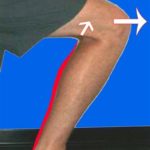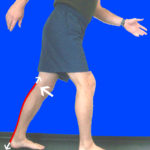Traditional Anatomy of the Soleus and Gastrocnemius
Most traditional anatomy books state that the soleus muscle assists in plantar flexing the ankle (i.e., pushing down the foot) when the knee is bent. Similarly, they also tell us that the gastrocnemius plantar flexes the ankle (when the knee is straight), and because it crosses the knee, it also assists in flexing the knee. However, the functional anatomy of the calf muscles includes how these structures work in response to gravity and ground reaction forces – information that is vital when designing effective corrective exercise programs.
Functional Anatomy of the Calf Muscles
Whenever the heel strikes the ground during gait, lunging or a squat, the lower leg (tibia) continues to travel forward over the foot (dorsiflex) and the knee bends, causing the soleus to stretch (see Picture 1). As the knee straightens when the leg travels behind the hip into extension, the gastrocnemius stretches (see Picture 2). These muscles are not getting looser as they stretch; on the contrary, they are lengthening under tension as they try to slow down forces to the knee and ankle joints as they bend and straighten.

Picture 1: Increasing tension to the soleus muscle

Picture 2: Increasing tension to the gastrocnemius muscle
To better understand how these muscles function as they lengthen under load, imagine stretching a rubber band with your fingers. The more you pull it apart the more tension there is in the rubber band. As muscles lengthen, tension increases to protect joints that the muscles cross from excessive wear and tear. Therefore, the true function of the calf muscles is to slow down forces to the knee and ankle joints as they bend and straighten when the foot is in contact with the ground. Understanding how these muscles work in real life will help you select and design better corrective exercises to help your clients eliminate their aches and pains.
To learn more about functional anatomy and how all of the major muscles in the body work in real-life check out Module 2 (i.e., Understanding Muscles and Movement) of The BioMechanics Method Corrective Exercise Specialist program or click on the image below.
